Planting and caring for ground cover roses.
Group ground cover roses surpasses any other in the diversity of its species and forms. Among them you can find both low-growing plants with long stems creeping along the ground, and taller ones, in which they droop picturesquely. Some, blooming with double flowers, have an emphatically romantic appearance, others are decorated more modestly - with flowers of simple shapes, but this does not lose at all. With all the external diversity, these roses have two very valuable properties in common: they are distinguished by an unusually abundant flowering and the ability to maintain their magnificent outfits until autumn.
Ground cover roses include varieties with such distinctive features as frost resistance, significant lateral growth, rich long flowering, abundant shoot coverage with shiny small leaves, resistance to black spot and powdery mildew - the most common diseases of roses.
Planting ground cover roses
Choice of landing site. Ground covers, like any other types of roses, are very fond of light. The presence of proper access to sunlight guarantees long flowering and the formation of buds, but at the same time, direct contact with the scorching midday sun is not desirable for plants - the petals can get burned and wither. Planting in shady areas of the yard and in the garden under trees or against walls is not recommended, as the root system of roses can get sick, growth will slow down and the plant may die.

For planting roses, you need to choose sunny places.
It is favorable to plant ground cover roses in the southeast or west side of the site, where the sun's rays will be in the morning, and the shade from shrubs and trees will help create the necessary protection in the midday heat.
Another very important point is that it is necessary to plant roses under a slope and preferably at a height of 30-40 centimeters - to drain melt water in the spring. Elevated planting guarantees effective access to the sun in summer and protection from severe frosts in winter. It is necessary to take into account, when planting, the degree of soil moisture in the area - roses do not tolerate excessive moisture and acidity, and in winter, a high level of moisture in the soil contributes to hypothermia of the root system.
When to plant ground cover roses. For regions with warm winters, autumn planting of creeping and carpet roses in open ground is more preferable, and for areas with harsh and frosty winters, planting in spring will be more reliable.
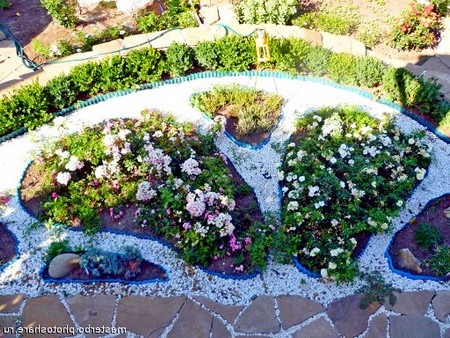
In regions with cold winters, planting roses in spring is preferable.
When planting roses in autumn in open ground, it is necessary to shorten the shoots a little, since the main pruning of the flower is always done in the spring. During spring planting, the shoots are cut in such a way that strong plants have 2-3 buds, weak ones have 1-2.
Landing site preparation. Groundcover roses tend to droop low or trail along the ground, so weeding and caring for roses can be a difficult task. To simplify it, the landing site should be prepared: remove large weeds, weed the soil. It is allowed to process it with Roundup followed by loosening.
All these actions are aimed at removing the stems and roots of harmful plants here and now. However, this is not enough, in order to further facilitate the care of plants, it is necessary to prevent their growth in the future. To do this, the soil between the planted bushes is mulched with bark, sawdust, decorative wood chips, black film. The thickness of the bulk mulch should be at least 3-4 cm so that weed seeds cannot germinate through it.
As for the composition of the soil, the most favorable soil for planting any roses is loamy, well transporting moisture and oxygen to the rhizome of the plant. Seedlings are poorly accepted and thrive in dry, sandy soils that overheat in summer, freeze in winter and retain nutrients poorly. The optimal variant of soil acidity is a soil with a slightly acidic reaction ranging from 5.5 to 6.5 pH.
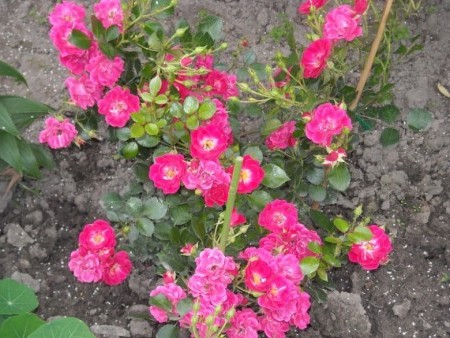
Planting ground cover roses
Planting ground cover roses. For planting ground cover roses, holes are formed in the selected area with a depth of 50-70 cm and a diameter of about 50 cm, it is also possible to dig a trench of the same depth and width as the planting hole during mass planting. The depth of the pit for planting is formed based on the length of the roots of the seedling plus 10-20 cm.
During planting, it is advisable to water the soil in layers, which fills the hole - this way you prevent the formation of voids, and after planting, you need to tamp the topsoil, water it abundantly and spud the rose. After the new growth on the bush reaches 5 cm, it is recommended to unravel and mulch the roses.
Depending on the variety of ground cover roses, per 1 sq. meter planted from one to three seedlings.
Caring for ground cover roses
Caring for ground cover roses does not differ much from caring for other types of roses. Creeping roses are considered unpretentious. They are rarely affected by diseases and are able to forgive some mistakes in care. The most important thing is to water them regularly and fertilize as needed.
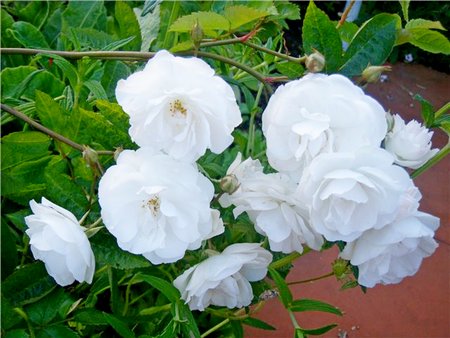
Caring for ground cover roses. How to water roses.
How to water. Watering should be done in the morning or when the sun does not shine directly on the bushes. If you neglect this rule, then the water that gets on the leaves will cause them to burn. For the same reason, it is impossible to spray and fertilize in the open sun.
As for the regularity of watering, both overflowing and underfilling are equally destructive for roses. Focus on the condition of the soil. It is necessary to water when the top layer of the earth dries out by 3-4 cm. In autumn, watering is reduced, gradually transferring the plants to a dormant period.
How to fertilize. Good care for roses is, first of all, top dressing! During the growing season, ground cover roses can be fed 3 times. The first top dressing is carried out in early spring, 2 weeks after the appearance of leaves. As a fertilizer, you can use the drug "Cytovit", "Agricola for flowering plants" or other complex fertilizers with a ratio of components: nitrogen (N) - 1, phosphorus (P) - 2 and potassium (K) - 1 part.
The second top dressing is carried out after about a month, and fertilizers are not applied during the flowering period. To stimulate the second wave of budding, re-flowering varieties of roses are fertilized immediately after the end of the first flowering (it is recommended to cut off the faded buds if the rose itself does not shed them). In the autumn, fertilizing is carried out only with potash fertilizers for good ripening of the shoots.
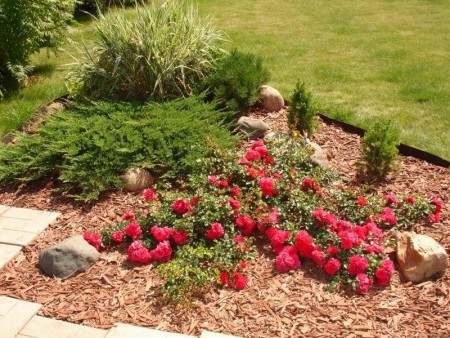
Ground cover roses do not require annual pruning, which greatly facilitates the care of these plants.
Rose cutting. Ground cover roses are practically self-forming, do not require careful annual pruning, and this greatly simplifies the care of these plants. They bloom on shoots of different ages.
Many experts recommend not pruning ground cover roses at all in order to maintain their natural shape. The most important requirement when planting ground cover roses is to plant them at such a distance from one another that the plants do not interfere with each other.
Shelter for the winter
Many varieties of ground cover roses, especially stunted ones, are able to winter without special shelter - under a layer of snow. In snowy and harsh winters, you should not hope for such a natural “fur coat”. It is best to cover the lashes of ground cover roses with spruce branches or build a wire frame and throw lutrasil on it. The air layer above the roses will reliably protect them from the winter weather.
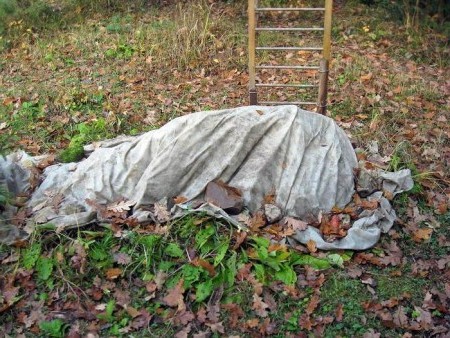
Rose care in winter You can build a wire frame and throw lutrasil on it.
Shoots of tall ground cover scrubs should be tried to be bent to the ground. Bent branches are placed on a layer of spruce branches, otherwise plants in contact with the ground under cover may rot. From above, the shoots are also covered with spruce branches or other insulating material.
Reproduction of ground cover roses

Propagation of ground cover roses by layering.
Ground cover roses are propagated by green cuttings and layering. The easiest way is to make layering. To do this, in the spring, press one or more shoots to the ground, fix them with wire hooks and dig in. The top of the shoot should remain on the surface.
Keep the soil moist throughout the summer. No more care for layering is required. Leave the layers to winter with the mother plant, it will be more reliable. The next spring, separate the young plants and plant in a permanent place.
Ground cover roses in garden design
Their main purpose is to cover the ground with dense leafy shoots growing horizontally and abundant inflorescences. The use of ground cover roses is largely determined by the nature of their growth.
These roses, with their long shoots studded with numerous clusters of inflorescences, can be planted in any corner of the garden. They can be planted in flower beds, rocky areas of land, decorate slopes with them and cover hatches. Some high-growing varieties are grown like climbing roses, directing their shoots up onto supports.
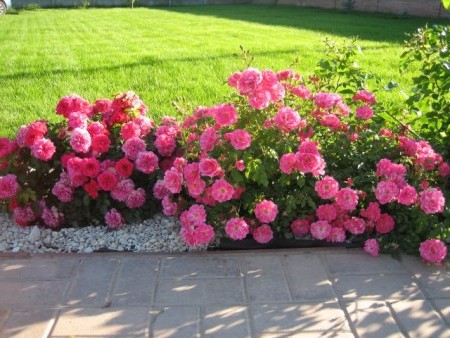
Ground cover roses in garden design.
Ground cover roses have many faces and can be used in landscape design for different purposes. The simplest thing is to plant rose bushes on a green lawn.
![]()
Ground cover roses are planted as border plants.
Low-growing ground cover varieties can decorate paths and flower beds as a border.
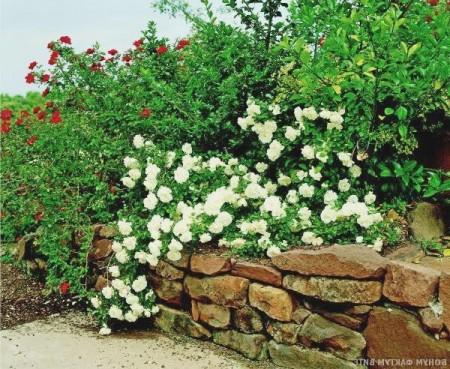
Ground cover roses in a tiered garden.
Cascades of blooming ground cover roses falling from retaining walls, stone stairs, and hills add originality to a multi-level garden.
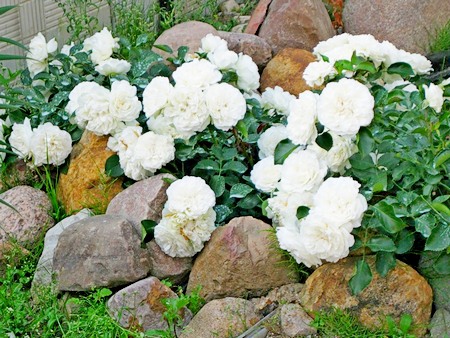
Roses look spectacular among the stones, they are often planted in rockeries and on hills.
Low-growing varieties that creep along the ground also look spectacular among stones, so they are often planted in rockeries and on hills.

Roses can be planted in containers and flowerpots.
Since ground cover roses have a very dense and dense bush, they can be grown in containers and flowerpots, planted on open terraces.
The best varieties of ground cover roses

Fae.
Fae. The bush is falling, compact, plant height - 60 - 80 cm, the leaf is small, glossy, dark green. Disease resistance is very high, frost-resistant variety, tolerates shade well, planting density is 5 pcs/m2.

Swany
Swany. Forms a spreading profusely flowering bush. The flowers are pure white, with a delicate pink tone in the center, when they first bloom, densely double, in the form of rosettes. Appear in racemes of 5-20 pieces on rather long stems. Height 60 - 70 cm. Width 150 cm. The variety is resistant to powdery mildew.














